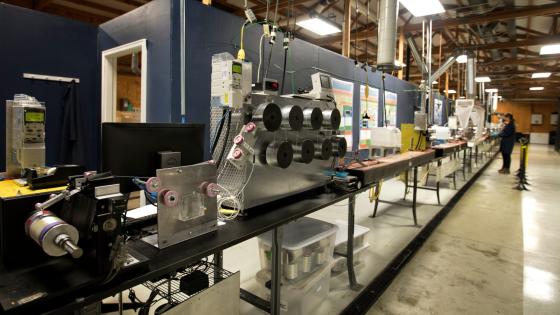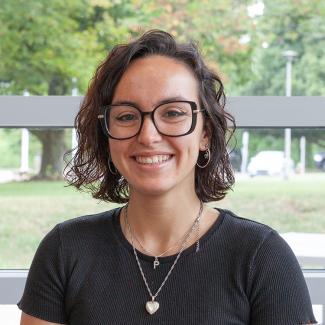
Carbon Materials Developing innovative materials to improve strength, efficiency, and sustainability.
Carbon Fiber Research
UK CAER operates one of the only production lines for spinning experimental fibers and precursor carbon fiber in the United States. Our team is uniquely positioned to partner with industry on the development of new fibers and new carbon fiber products.
Carbon Nanotubes
UK CAER has been involved with multi-walled carbon nanotube (MWCNT) synthesis and research since the mid 1990s. Our research has explored many of the desirable properties that MWCNTs exhibit, including strength, stiffness, electrical conductivity, and thermal conductivity.
Polymer Processing
For nearly 20 years, UK CAER has been involved in polymer processing research. Working with both thermosets and thermoplastics, research in this area has focused on mixing fillers into the polymers to improve their mechanical and electrical properties.
Active Projects
Improving Carbon Fiber Technology
Carbon fiber is the material of the future — a next-generation version of aluminum. Its properties are often considered the holy grail in manufacturing. Carbon fiber is a low-weight, high-strength, corrosion resistant material that can conduct electricity. The University of Kentucky Center for Applied Energy Research (UK CAER) is home to the largest carbon fiber spin line at any institution in North America. Over the past decade, our researchers have built a solution spinning line that draws visitors, collaborators, and research partners from across the Commonwealth, the nation and the world. And they are here for one thing: to lean on UK CAER’s carbon fiber research team as they seek answers to some of the toughest questions facing the industry.
Exploring the Potential of Carbon Nanotube Technology
When carbon nanotubes (CNT) were first discovered in the early 1990s, it sparked a revolution in materials science. These incredible structures have an array of fascinating electronic, magnetic and mechanical properties. CNT are at least 100 times stronger than steel, but only one-sixth as heavy, so nanotube fibers could strengthen almost any material. Nanotubes can conduct heat and electricity far better than copper. CNT are already being used in polymers to control or enhance conductivity and are added to anti-static packaging. For nearly two decades, UK CAER scientists have been involved in multi-walled carbon nanotube (MWCNT) synthesis and research. During that time, the carbon materials group researched many of the desirable properties that MWCNTs exhibit, including strength, stiffness, electrical conductivity, and thermal conductivity. Additionally, the group has worked extensively to make multi-walled carbon nanotubes more accessible by driving down their cost through continuous production technology.
The Spinline
Get a look behind the scenes at the University of Kentucky Center for Applied Energy Research's Carbon Precursor Fiber Spinline, the largest of its kind in North America.
Featured Publications
Ruben Sarabia-Riquelme, Warren C. Schimpf, Danielle L. Kuhn, Matthew C. Weisenberger, “Influence of relative humidity on the structure, swelling and electrical conductivity of PEDOT:PSS fibers”, Synthetic Metals 297 (2023) 117399, https://doi.org/10.1016/j.synthmet.2023.117399
Ercan Cakmak, James C. Hower, Jonathan P. Mathews, Matthew C. Weisenberger, Rachel Kaplan, Justin Lacy, Yuxuan Zhang, Edgar Lara-Curzio, “Microstructural diversity and digestion yields of select bituminous and subbituminous coals as raw material candidates for carbon fiber precursor production”, Fuel, 348 (2023) 128545, https://doi.org/10.1016/j.fuel.2023.128545
Joshua Malzahn, Ignacio Preciado, Ding Wang, Matthew Weisenberger, Eric Eddings, “Effect of Secondary Gas-Phase Reactions (SGR) in Pyrolysis of Carbon Feedstocks for Anisotropic Carbon Materials Production – 2: Effects of SGR on Tars Produced From Varying Ranks of Coal”, Journal of Analytical and Applied Pyrolysis, Vol. 165, August (2022), 105579, https://doi.org/10.1016/j.jaap.2022.105579
Joshua Malzahn, Ignacio Preciado, Ding Wang, Matthew Weisenberger, Eric Eddings, “Effect of Secondary Gas-Phase Reactions (SGR) in Pyrolysis of Carbon Feedstocks for Anisotropic Carbon Materials Production – 1: Controlling SGR to Improve Pitch Anisotropy”, Journal of Analytical and Applied Pyrolysis, Vol. 164, June (2022), 105541, https://doi.org/10.1016/j.jaap.2022.105541
Matthew Weisenberger, Rodney Andrews, Ignacio Martin-Gullon, “Highlights of CARBON 2019 – Commentary and introduction to the virtual special issue”, Carbon 182 (2021) 316-317, Carbon, 178 (2021) 223-232, https://doi.org/10.1016/j.carbon.2021.03.004
E. Ashley Morris, Ruben Sarabia-Riquelme, Nik Hochstrasser, Jordan Burgess, Anne E. Oberlink, David E. Eaton, Matthew C. Weisenberger, “Early development of multifilament polyacrylonitrile-derived structural hollow-carbon fibers from a segmented arc spinneret”, Carbon, 178 (2021) 223-232, https://doi.org/10.1016/j.carbon.2021.03.004
Ruben Sarabia-Riquelme, Rodney Andrews, John E. Anthony, Matthew C. Weisenberger, “Highly conductive wet-spun PEDOT:PSS fibers for applications in electronic textiles”, Journal of Materials Chemistry C, Issue 33, 2020, DOI: 10.1039/d0tc02558e
Zhen Fang, Matthew C. Weisenberger, Mark S. Meier, “Utilization of lignin-derived small molecules: Epoxy polymers from lignin oxidation products”, ACS Applied Bio Materials, (2020), 3, 2, 881-890, https://doi.org/10.1021/acsabm.9b00954
Matthew C. Weisenberger, Jordan Burgess, Harold H. Schobert, James C. Hower, “Thermal properties of Pennsylvania anthracite”, Fuel 266 (2020) 117101, https://doi.org/10.1016/j.fuel.2020.117101
Ruben Sarabia-Riquelme, Camila Gomez, Dali Qian, John Craddock, Matthew Weisenberger, “Tailoring the seebeck coefficient of spray-coated Poly (3,4-ethylenedioxythiophene): Poly(styrenesulfonate) films with nitrogen doped multiwalled carbon nanotubes”, Journal of Nanoscience and Nanotechnology, 20 (2020), 6, 3576-3581
Ruben Sarabia-Riquelme, Maryam Shahi, Joseph Brill, Matthew Weisenberger, “The effect of drawing on the electrical, thermoelectrical and mechanical properties of wet-spun PEDOT:PSS fibers”, ACS Applied Polymer Materials (2019), 1, 2157 – 2167. DOI: 10.1021/acsapm.9b00425
Jason D. Ryan, Anja Lund, Anna I,. Hofmann, Renee Kroon, Ruben Sarabia-Riquelme, Matthew C. Weisenberger, and Christian Müeller, “All-Organic Textile Thermoelectrics with Carbon-Nanotube-Coated n-Type Yarns”, ACS Applied Energy Materials (2018), 1, 2934-2941. DOI: 10.1021/acsaem.8b00617
Nisa V. Salim, Sarah E. Edrington, E. Ashley Morris, Matthew C. Weisenberger, “Analyses of closed porosity of carbon fiber precursors using a robust thermoporosimetric method”, Polymer Testing 67 (2018) 151-158. https://doi.org/10.1016/j.polymertesting.2018.01.030
Ruben Sarabia-Riquelme, John Craddock, E Ashley Morris, David Eaton, Rodney Andrews, John Anthony, Matthew C Weisenberger, “Simple, low-cost, water-processable n-type thermoelectric composite films from multiwall carbon nanotubes in polyvinylpyrrolidone”, Synthetic Metals, Vol. 225, March 2017, Pages 86-92. https://doi.org/10.1016/j.synthmet.2016.11.014
John D. Craddock, Jordan J. Burgess, Sarah E. Edrington, Matthew C. Weisenberger, “Method for direct measurement of in-plane carbon fiber thermal diffusivity using laser flash technique”, Journal of Thermal Science and Engineering Applications MARCH 2017, Vol. 9 / 014502-1 – 014502-3, DOI: 10.1115/1.4034853
John D. Craddock, Terry Rantell, James C. Hower, David T. Whitlow, John Wiseman, Matthew C. Weisenberger, “Anode Coke from Coal – A Low Cost Approach”, FUEL, 2017, 229-241, http://dx.doi.org/10.1016/j.fuel.2016.09.045
Ruben Sarabia-Riquelme, Gloria Ramos-Fernández, Ignacio Martin-Gullon, Matthew C Weisenberger, “Synergistic effect of graphene oxide and wet-chemical hydrazine/deionized water solution treatment on the thermoelectric properties of PEDOT: PSS sprayed films”, Synthetic Metals, 2016, 222, 330-337. https://doi.org/10.1016/j.synthmet.2016.11.013
Nicolas E. Holubowitch, James Landon, Cameron A Lippert, John D. Craddock, Matthew C. Weisenberger, Kunlei Liu, “Spray-Coated Multiwalled Carbon Nanotube Composite Electrodes for Thermal Energy Scavenging Electrochemical Cells”, ACS Applied Materials & Interfaces, 2016, 8 (34), 22159–22167, DOI: 10.1021/acsami.6b05083
Bernhard Dörling, Jason D. Ryan, John D. Craddock, Andrea Sorrentino, Ahmed El Basaty, Andrés Gomez, Miquel Garriga, Eva Pereiro, John E. Anthony, Matthew C. Weisenberger, Alejandro R. Goñi, Christian Müller, and Mariano Campoy-Quiles, “Photoinduced p- to n-type Switching in Thermoelectric Polymer-Carbon Nanotube Composites”, Advanced Materials, 2016, doi:10.1002/adma.201505521
E. Ashley Morris, Matthew C. Weisenberger, Mohamed G. Abdallah, Frederic Vautard, Hippolyte Grappe, Soydan Ozcan, Felix L. Paulauskas, Cliff Eberle, Dave Jackson, Sue J. Mecham, Amit K. Naskar, “High Performance Carbon Fibers from Very High Molecular Weight Polyacrylonitrile Precursors”, CARBON 101 (2016), 245 – 252, DOI: 10.1016/j.carbon.2016.01.104
E. Ashley Morris, Matthew C. Weisenberger, Gregory Wilson Rice, “Properties of PAN Fibers Solution Spun into a Chilled Coagulation Bath at High Solvent Compositions”, Fibers 2015 (3) 4 560 – 574; doi:10.3390/fib3040560 (Invited Paper)
John D. Craddock, Dali Qian, Catherine Lester, John Matthews, J. Patrick W. Mansfield, Richard Foedinger, Matthew C. Weisenberger, “Continuous processing of multi-walled carbon nanotube-studded carbon fiber for enhanced through-thickness thermal diffusivity composites”, Journal of Nanoscience and Nanotechnology, Vol. 15, No. 9, pp. 6852 – 6855, Sept (2015), DOI: http://dx.doi.org/10.1166/jnn.2015.11620
John D. Craddock, Matthew C. Weisenberger, “Harvesting of large, substrate-free sheets of vertically-aligned multiwall carbon nanotube arrays”, CARBON 81 (2015) 839 – 841, DOI: 10.1016/j.carbon.2014.09.039
E. Ashley Morris, Matthew C. Weisenberger, Stephanie B. Bradley, Mohamed G. Abdallah, Sue J. Mecham, Priya Pisipati, James E. McGrath, “Synthesis, Spinning, and Properties of Very High Molecular Weight Poly(acrylonitrile-co-methyl acrylate) for High Performance Precursors for Carbon Fiber”, POLYMER, 2014, 55(25), 6471-6482. http://dx.doi.org/10.1016/j.polymer.2014.10.029
E. Ashley Morris and Matthew C. Weisenberger, “Solution Spinning of PAN-Based Polymers for Carbon Fiber Precursors”, ACS Books Symposium Series, Volume Polymer Precursor-Derived Carbon edited by Amit K. Naskar, Dennis W. Smith, Jr., James E. McGrath, Wesley P. Hoffman, Published to web 14 Oct. 2014, doi: 10.1021/bk-2014-1173.ch009













